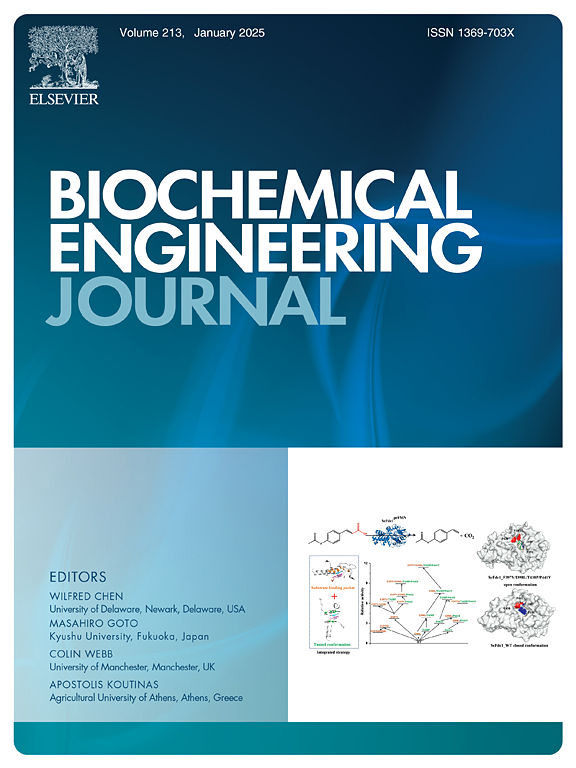Immobilization of a novel formaldehyde-degrading fungus in polyvinyl alcohol–sodium alginate beads for continuous wastewater treatment
IF 3.7
3区 生物学
Q2 BIOTECHNOLOGY & APPLIED MICROBIOLOGY
引用次数: 0
Abstract
This study introduces a novel formaldehyde-degrading fungus, identified as Geotrichum sp. YC8 based on microscopic morphology and internal transcribed spacer gene sequence analysis. The strain can efficiently degrade 100 mg/L formaldehyde even under high-salinity conditions (50 g/L NaCl) or at an acidic pH of 2.0. Optimal degradation conditions, determined via response surface methodology, were 31.4 °C, pH 5, and 12 % inoculum. YC8 cells were encapsulated in a polyvinyl alcohol–sodium alginate hydrogel to enhance biodegradation, with an optimal formulation of 2 % sodium alginate, 6 % polyvinyl alcohol, and 3 % calcium chloride. The impact of hydrogel bead size on mass transfer efficiency was also evaluated. Batch tests revealed that immobilized cells were more resilient, achieving complete degradation of 800 mg/L formaldehyde within 55 h. Both free and immobilized cells exhibited first-order kinetics at low concentrations and zero-order kinetics at high concentrations. The immobilized cells maintained stable performance in a fluidized bed reactor, enabling continuous degradation of 900 mg/L formaldehyde. This study highlights YC8 as a promising agent for practical formaldehyde degradation applications.
一种新型甲醛降解真菌在聚乙烯醇-海藻酸钠微球中固定化连续处理废水
本文介绍了一种新的甲醛降解真菌,通过显微形态和内部转录间隔基因序列分析鉴定为Geotrichum sp. YC8。该菌株在高盐度条件下(50 g/L NaCl)或酸性pH为2.0时也能有效降解100 mg/L甲醛。通过响应面法确定的最佳降解条件为31.4 °C, pH为5,接种量为12% %。将YC8细胞包裹在聚乙烯醇-海藻酸钠水凝胶中,以增强生物降解,最佳配方为2 %海藻酸钠,6 %聚乙烯醇,3 %氯化钙。研究了水凝胶粒径对传质效率的影响。批量试验表明,固定化细胞更有弹性,在55 h内完全降解800 mg/L甲醛。游离细胞和固定化细胞在低浓度下均表现为一级动力学,在高浓度下表现为零级动力学。固定化细胞在流化床反应器中保持稳定的性能,可连续降解900 mg/L甲醛。本研究强调了YC8作为一种有前景的甲醛降解剂的实际应用。
本文章由计算机程序翻译,如有差异,请以英文原文为准。
求助全文
约1分钟内获得全文
求助全文
来源期刊

Biochemical Engineering Journal
工程技术-工程:化工
CiteScore
7.10
自引率
5.10%
发文量
380
审稿时长
34 days
期刊介绍:
The Biochemical Engineering Journal aims to promote progress in the crucial chemical engineering aspects of the development of biological processes associated with everything from raw materials preparation to product recovery relevant to industries as diverse as medical/healthcare, industrial biotechnology, and environmental biotechnology.
The Journal welcomes full length original research papers, short communications, and review papers* in the following research fields:
Biocatalysis (enzyme or microbial) and biotransformations, including immobilized biocatalyst preparation and kinetics
Biosensors and Biodevices including biofabrication and novel fuel cell development
Bioseparations including scale-up and protein refolding/renaturation
Environmental Bioengineering including bioconversion, bioremediation, and microbial fuel cells
Bioreactor Systems including characterization, optimization and scale-up
Bioresources and Biorefinery Engineering including biomass conversion, biofuels, bioenergy, and optimization
Industrial Biotechnology including specialty chemicals, platform chemicals and neutraceuticals
Biomaterials and Tissue Engineering including bioartificial organs, cell encapsulation, and controlled release
Cell Culture Engineering (plant, animal or insect cells) including viral vectors, monoclonal antibodies, recombinant proteins, vaccines, and secondary metabolites
Cell Therapies and Stem Cells including pluripotent, mesenchymal and hematopoietic stem cells; immunotherapies; tissue-specific differentiation; and cryopreservation
Metabolic Engineering, Systems and Synthetic Biology including OMICS, bioinformatics, in silico biology, and metabolic flux analysis
Protein Engineering including enzyme engineering and directed evolution.
 求助内容:
求助内容: 应助结果提醒方式:
应助结果提醒方式:


